Soft plastics are a big part today’s sportfishing scene and anglers must have some knowledge of jigheads. Although many anglers have a good grasp of jigheads and how to use them, I still get lots of questions regarding them. This month we will take an in-depth look at jigheads.
I remember when Steve Morgan took me out for my maiden soft plastics session. Prior to the trip he told me to go down to the tackle store and buy some jigheads. My initial reaction was “What is a jighead?” I quickly learnt that a jighead is a hook with a lump of lead melted just below the eye of the hook. It’s pretty much a hook with a sinker attached to it. A jighead lets an angler rig a soft plastic on a hook, cast it the required distances and helps a plastic sink to the desired depth.
Just to make it confusing for beginners, there are a variety of jigheads on the market that are all designed to do different things. If you investigate the jighead section of your local tackle shop, you will come across ball, bullet and keel head jigheads, hidden weight system and torpedo style jigheads, weedless or all terrain style jigheads and the list goes on! If you are new to soft plastic angling don’t let yourself become overwhelmed. Start with a stock standard jighead such as a Berkley Bream Pro jighead, TT standard jighead or Squidgy ball head jighead. These jigheads have a piece of lead near the eye of the hook and a piece of wire or ribbed lead that is designed to hold the plastic on the hook.
One of the most critical aspects of jighead selection is selecting the right jighead weight to use. Many anglers struggle to catch fish using soft plastics because they select the wrong weighted jighead for the water conditions they fish. Have you ever watched a school of fish feeding in the water below a jetty? Fish will happily eat pieces of bread or prawn but often aren’t interested in a baited hook and sinker. The fish refuse the bait because it does not look right. It won’t sink naturally (slowly) like the bread or prawn does when thrown in.
The same is true when selecting jighead weights. If you choose a jighead that is too heavy then it will sink unnaturally fast and deter most fish interested in your soft plastic. So how do you select the right weight? A good rule of thumb is to try and select a jighead weight that will only just get your plastic to the bottom. This often means experimenting with different weights until you find the best one. It also means being patient as you wait for light jigheads to sink until the bottom is felt. If you fail to hit the bottom as a jighead drifts quickly with current then it is time to increase the weight. Current flow also needs to be considered and will change throughout the day. Anglers regularly catch fish using a specific jighead weight and then find they are suddenly catching less fish. The tidal flow has probably changed and the jighead is either too heavy or light for the new current conditions. I didn’t say it was easy, but when you get it right it can make a big difference!
After selecting the right jighead weight to use, anglers need to decide what hook size to rig the soft plastic on. When rigging a soft plastic, I like to have enough hook gape protruding to hook a fish, but not so much that fish will see the hook. Photo 10 illustrates good hook sizes with which to rig a soft plastic.
To get the best results from rigging soft plastics you may have to change your perspective. By this I mean start to visualise what your soft plastic is doing when it is down among the fish. By giving yourself a mental picture of what is happening below the water surface you can focus on presentation. Presentation is all about making your soft plastic look like a piece of food a fish will readily accept and eat. The good news is that most soft plastics are designed to help you do that.
The trick to rigging soft plastics is to set them up on the hook so they swim or sink naturally. Getting soft plastics to look natural in the water is all about rigging them straight on the hook! A soft plastic that is rigged straight on a hook is aerodynamic and will not twist unnaturally in the water. A good habit to get into when out on the water is to swim your plastic in the water at your feet once you have rigged a plastic. If it swims straight you have achieved your goal, but if it twists around then it might be worth having another go! Photos 3 to 10 show exactly how to achieve a well-rigged soft plastic.
Photo 3: Place the soft plastic and jighead side-by-side to establish where the point of the hook should exit the plastic so that it lies flat along the shank of the hook.
Photo 4: Pierce the soft plastic through the mid-point of the head of the plastic.
Photo 5: Thread the plastic along the hook just as you would a prawn or worm. Push the hook point out through the plastic at the approximate point you identified in Photo 3.
Photo 6: As the hook point is pushed through the plastic, make sure it exits through the centre of the plastic. For example, if you drew an invisible line down the centre of the soft plastic, the hook would exit through this line. The hook is rigged through the centre of the head and runs through the centre of the plastic’s body so it should swim straight in the water.
Photo 7: Push the soft plastic up along the shank of the hook until it meets the lead keeper. Then using some force, push the plastic up over and on to the lead keeper until the plastic hits the head of the jighead. It should be difficult to pull the plastic off the hook once this is achieved which is what you want. If you find it difficult to pull the plastic down the hook then so will the fish. Fish usually have a few bites at the soft plastic before striking and will reject a soft plastic that hasn’t been rigged properly.
Photo 8 and 9: A properly rigged soft plastic lies symmetrically on the hook from every angle.
Photo 10: Different types of soft plastics rigged properly on the correct hook sizes.
Darren is a lurefishing beginner who is also our Back to Basics guinea pig. Each month Darren aims to show other novices how to use the information provided in this column.
This month Darren improved his casting and began experimenting with jigheads and rigging plastics. Getting the soft plastics to sit straight on the jighead was one of the biggest challenges. Rigging soft plastics is a task that feels quite awkward to begin with but will gradually become second nature. We started Darren rigging bigger plastics (4”) which made his life a bit easier. He is pictured holding a trevally that grabbed a quickly retrieved Berkley soft plastic. These fish will refuse plastics that do not swim well at high speeds.
The science of selecting the optimal jighead to use for different occasions, and how to rig a soft plastic is not complex. By putting some thought into what you are trying to achieve and experimenting until you get good results, you will be well on the way to catching fish and having a whole lot of fun.
Reads: 19405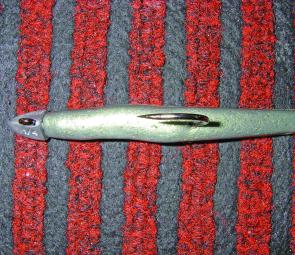


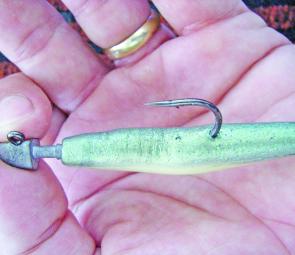


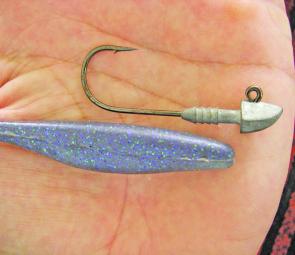
Darren with a trevally that grabbed a quickly retrieved Berkley soft plastic.
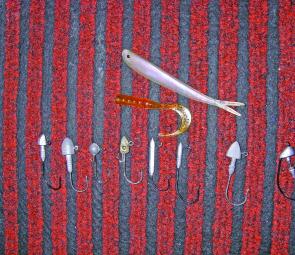
(From top to bottom) Berkley Bream Pro jighead, TT standard jighead, Squidgy ball head jighead.
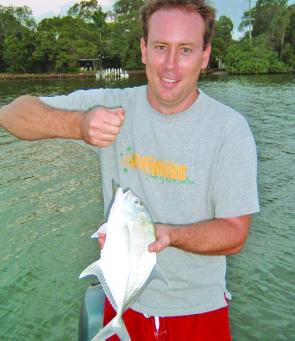
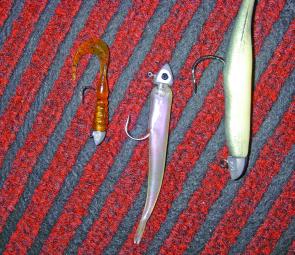
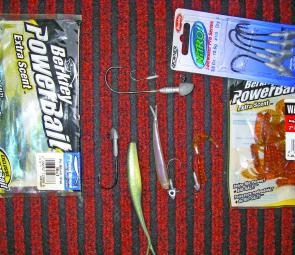
If you investigate the jighead section of your local tackle shop, you will come across ball, bullet and keel head jigheads, hidden weight system and torpedo style jigheads, weedless or all terrain style jigheads and the list goes on!




